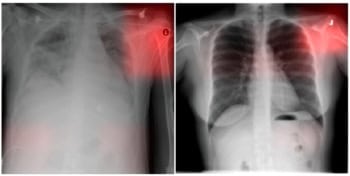
A label-free fluorescence microscopy technique can detect the metabolic and structural signatures of cancer in epithelial tissue even before it develops. A team in the US and Spain used two-photon excitation fluorescence (TPEF) microscopy to map the presence of two metabolism-related coenzymes in cervical biopsy samples. They found that the distribution and ratio of the coenzymes vary with depth in a way that picks out changes in morphology associated with precancerous lesions. The researchers say that the method may ultimately be incorporated into routine screening to identify cancers early on, when treatment is most effective.
When a cancer has grown to the point at which it can be diagnosed from the symptoms that it causes, it might already be too late for successful treatment. Far better is to catch the cancer before it develops, but this means spotting the subtle biochemical changes that indicate that a cell’s metabolism has ramped up ready for proliferation.
While it is possible to measure these changes non-invasively, current techniques – nuclear medicine or MRI, for example – require dedicated imaging facilities and the injection of tracers. The alternative is to take biopsies for laboratory analysis, but tissue sampling sites are still typically chosen using low-specificity and sub-optimal-sensitivity visual means, and the procedure can cause pain and other side effects.
Writing in Cell Reports Medicine, Irene Georgakoudi and colleagues at Tufts University and Tufts Medical Center in the US, and the University of Málaga in Spain, show that TPEF can measure precancerous biochemical cues non-invasively and without the need for injected tracers.
In conventional fluorescence microscopy, specific molecules emit visible light when they are excited by higher-frequency photons. In TPEF microscopy, the target molecules emit after absorbing two relatively low-energy photons that, individually, could not trigger such fluorescence. This technique has an advantage for physiological applications because the two near-infrared (NIR) photons that excite the molecules are scattered less by tissue than higher-frequency light, allowing cells beneath the tissue surface to be imaged. The depth at which the NIR beam is focused can also be varied, giving a depth-resolved map of fluorophore distribution.
Georgakoudi and her colleagues exploited these advantages to quantify in samples of cervical epithelium the presence of two molecules: the reduced form of nicotinamide adenine dinucleotide (NAD(P)H) and flavin adenine dinucleotide (FAD).
“These enzymes play an important role in several of the pathways involved in producing energy and synthesizing molecules that the cell needs to survive,” explains Georgakoudi. “The balance of the pathways that the cell utilizes to do this often changes as it becomes cancerous.”
The relative quantities of FAD and NAD(P)H therefore give a window onto cancer-related metabolic changes, but they also provide a picture of how cells are structured. Because these molecules are concentrated in mitochondria (subcellular structures found in the cells’ cytoplasm but not in their nuclei and borders), their presence can be used to infer the cytoplasmic-to-nuclear ratio – the ratio of the size of the cell nucleus to the overall cell size – and the degree to which mitochondria cluster together. In healthy epithelia, both of these properties vary significantly with depth. “That is one of the markers that the cells are differentiating (maturing) as they are normally expected to do, as we move from the deeper cell layers of the epithelium to the surface,” says Georgakoudi.
In precancerous lesions, in contrast, this normal differentiation process is disrupted, and the epithelial cells display no such depth-dependent variation. The researchers found that this lack of differentiation was detectable by TPEF microscopy. Moreover, they found that the process of tissue classification could be automated by combining cell morphology and mitochondrial organization measurements with the FAD:(FAD+NAD(P)H) ratio, which also displayed less variability with depth in precancerous tissues.
Although Georgakoudi and colleagues studied cervical epithelial tissues specifically, in which cancer is usually caused by a particular strain of human papillomavirus, they say that the same cell-morphological and biochemical patterns should be present in many epithelial cancers. To apply the technique in the clinic, however, will require advances in the delivery of high-energy pulses and improvements in image acquisition speed.
“We are starting this summer a project to develop an instrument that will enable us to test this technique in humans in the clinic within two years,” says Georgakoudi. “It will of course take a couple of years at least to go through initial testing and optimization, but there is no question that the ability to assess subtle metabolic changes in human tissues in vivo will enable new insights into the process of cancer development so that we can detect and treat it more effectively.”



